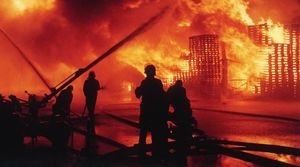
Thirty years ago, one of the worst environmental disasters in Europe was caused by a fire breaking out in an agrochemical warehouse at a Sandoz pharmaceutical company site near Basel, Switzerland. It was not the accident itself that caused the real disaster, but the contaminated fire-water — water used by firefighters to extinguish the blaze — that reached the Rhine. The toxic plume, 70 kilometres long, flowed through Switzerland, France, Germany and the Netherlands. It caused vast transboundary water pollution, threatened drinking water supplies and devastated fish stocks.
Could a similar accident still happen in Europe today? The shocking answer is yes. Although the Sandoz accident triggered many improvements in the area of industrial safety in European countries, the issue of fire-water retention has until now not been thoroughly addressed. In many countries, including those with a more advanced level of industrial safety like Germany, there are gaps in the national legislation and size requirements for fire-water retention basins remain inadequate.
This is about to change with the creation of an expert group under the auspices of UNECE tasked with elaborating guidance on fire-water retention. This guidance should help overcome the challenges in this area by compiling good practices and establishing general safety principles and recommendations for countries within and beyond the UNECE region.
A first meeting, gathering experts from Czechia, Finland, Germany, Hungary, Poland, Sweden and Switzerland under the UNECE Convention on the Protection and Use of Transboundary Watercourses and International Lakes and the UNECE Convention on the Transboundary Effects of Industrial Accidents, was held on 17 January 2017 in Geneva. Two further meetings are planned in June and September 2017, with a view to having the guidance adopted by the governing bodies of both Conventions in autumn 2018. Germany is the main donor for this project.
More information about the Joint Expert Group can be found at: www.unece.org/env/teia/jeg.html.
For further information, please contact
Ms. Claudia Kamke
Associate Environmental Affairs Officer
Convention on the Transboundary Effects of Industrial Accidents
United Nations Economic Commission for Europe
Email: [email protected]
Tel: +41 (0)22 917 12 11
Note to editors
Since the early 1990s UNECE has committed itself to the prevention of, preparedness for and response to industrial accidents, especially those with transboundary effects in its region. The 1992 Convention on the Transboundary Effects of Industrial Accidents (Industrial Accidents Convention) helps protect human beings and the environment against such accidents by preventing them as far as possible, reducing their frequency and severity and mitigating their effects. Issues related to the prevention of accidental water pollution are addressed in close cooperation with the 1992 Convention on the Protection and Use of Transboundary Watercourses and International Lakes (Water Convention). The guidance on fire-water retention is being developed under the leadership of the UNECE Joint Ad Hoc Expert Group on Water and Industrial Accidents, a joint group between the two UNECE Conventions.
Situation in Switzerland
Switzerland developed a Major Accident Ordinance (MAO), which was adopted five years after the Sandoz accident, in 1991. The MAO has a huge scope, covering 2,400 chemical establishments, 2,500 gas and oil pipelines, 3,600 kilometres of railway lines and 7,800 kilometres of main roads. As such, it is not limited to stationary chemical installations, unlike the corresponding legislation in Austria and Germany, for example. In 1995 and 1999, respectively, Switzerland joined the UNECE Water and Industrial Accidents Conventions. Under both Conventions it works actively with other UNECE member States to prevent, prepare for and respond to industrial accidents and accidental water pollution, especially with transboundary effects. Moreover, Switzerland developed guidance on fire-water retention, including on the size of fire-water retention basins, to help operators comply with national legislation. Following the Sandoz accident, the countries along the Rhine agreed to establish an International Alert Plan for the Rhine River. To date, seven alert centres have been set up between Basel and the Netherlands, ready to transmit an alert to downstream countries.
Situation in Germany
According to Mr. Wolfram Willand of the Regional Administrative Authority of Freiburg, the regulations introduced in Germany after the Sandoz accident were an improvement, but still offered only limited protection. According to Mr. Willand further fire-water retention requirements are needed in German legislation to ensure that not only storage facilities, but also industrial sites dealing with chemicals in production processes, are covered; without such changes, an accident like Sandoz could still be possible in Germany.
As a concrete example, on 1 June 2005 a fire broke out at a chemical company producing printed circuit boards in the Black Forest region. Large volumes of fire-water were produced. As the fire-water retention was calculated, in accordance with German law, only on the basis of the chemical storage and did not take into account the chemicals in the production process, the retention basins were too small and the fire-water could not be retained. Heavy rain was announced and there was a risk that 400 tons of chemicals would drain into the nearby Kinzig River, a tributary of the Rhine. In comparison, at the Sandoz accident approximately 10–30 tons of chemicals reached the Rhine. At immense cost, 70 special tanker trucks drove up to 500 kilometres to dispose of the contaminated fire-water at a suitable treatment plant.